The Intel Core i3-7350K (60W) Review: Almost a Core i7-2600K
by Ian Cutress on February 3, 2017 8:00 AM ESTProfessional Performance: Windows
Agisoft Photoscan – 2D to 3D Image Manipulation: link
Agisoft Photoscan creates 3D models from 2D images, a process which is very computationally expensive. The algorithm is split into four distinct phases, and different phases of the model reconstruction require either fast memory, fast IPC, more cores, or even OpenCL compute devices to hand. Agisoft supplied us with a special version of the software to script the process, where we take 50 images of a stately home and convert it into a medium quality model. This benchmark typically takes around 15-20 minutes on a high-end PC on the CPU alone, with GPUs reducing the time.
Here we report the overall time to complete the test – sub-test results can be found in Bench.
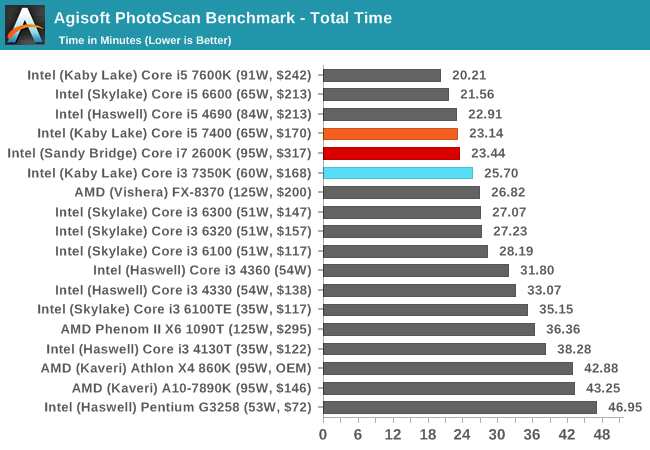
Photoscan is a mix of single and multi-threaded segments, but overall the extra cores in the i5/i7 beat the Core i3, but not by much.
Cinebench R15
Cinebench is a benchmark based around Cinema 4D, and is fairly well known among enthusiasts for stressing the CPU for a provided workload. Results are given as a score, where higher is better.
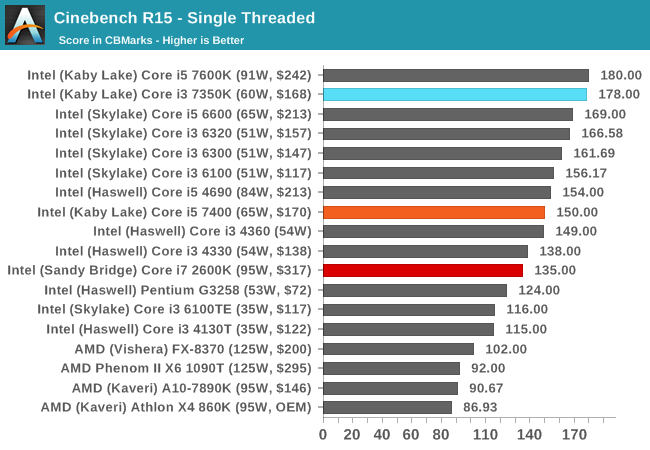
All the Kaby Lake processors seem to do well in CB15 single threaded performance, given that all the K-processors can reach 4.2 GHz or higher one way or another. Nonetheless, the age of the Core i7-2600K is showing here.
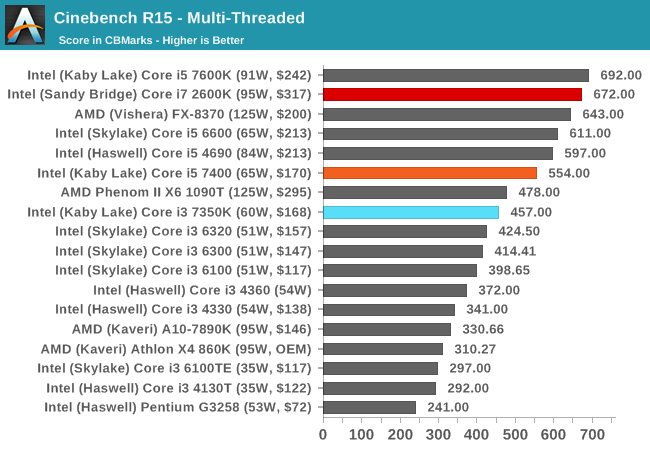
Turning the tables with actual cores, and the Core i7-2600K gets a significant leg up here. The Core i5 also sits above the Core i3.
HandBrake v0.9.9: link
For HandBrake, we take two videos (a 2h20 640x266 DVD rip and a 10min double UHD 3840x4320 animation short) and convert them to x264 format in an MP4 container. Results are given in terms of the frames per second processed, and HandBrake uses as many threads as possible.
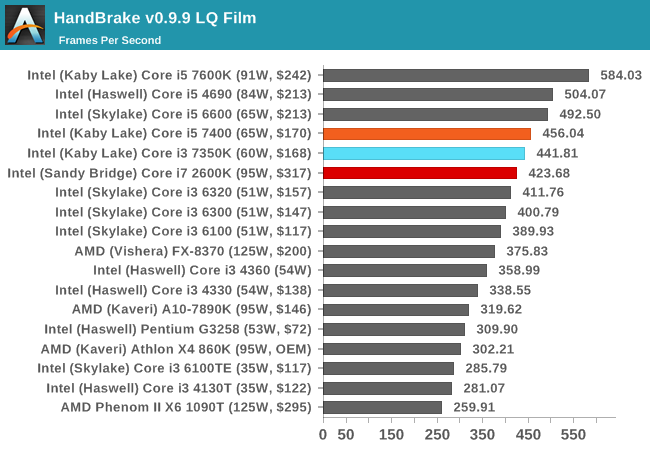

For video conversion, having small frames puts all three CPUs in a similar spot. But ramp up the frame size and we see the Kaby Lake i5 pull ahead due to IPC and instructions. The Core i3 has enough oomph to match the extra threads on the Core i7-2600K though.
Hybrid x265
Hybrid is a new benchmark, where we take a 4K 1500 frame video and convert it into an x265 format without audio. Results are given in frames per second.
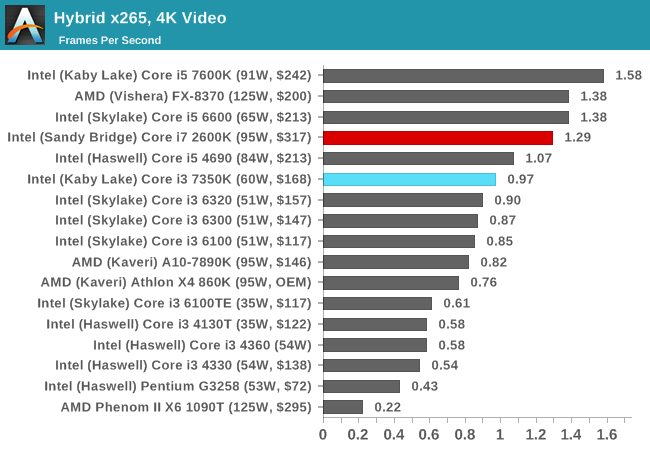
With a different video conversion tool and render, the extra cores and threads of the Core i7 is more than enough to give it a 30% advantage over the Core i3-7350K. It makes me wonder if another +30% frequency would help the Core i3.










186 Comments
View All Comments
fanofanand - Friday, February 3, 2017 - link
More to the point, the difference between SSD and HDD is bigger than the difference between Q6600 and i5 7400.BrokenCrayons - Friday, February 3, 2017 - link
I agree with fanofanand on this one. I previously owned a Q6600 and went through the trouble of upgrading to an Athlon x4 860K (recently died) with a lot more/faster RAM (16GB DDR3 2133 vs 4GB DDR2 800). The difference was pretty underwhelming. I've got a Haswell i7 at the office and was moving between it and the Q6600 and the difference in performance was something I noticed, but it didn't leave me feeling like the Q6600 was incomparably slow.Hrel - Friday, February 3, 2017 - link
I'm just gonna point out that anyone saying Intel is in trouble, needs to realize that they have intentionally chosen to not improve CPU performance for several years, instead focusing on improving the integrated GPU. Look how much that's increased! That's in addition to incrementally improving CPU performance.Intel can start channeling their immense resources into improving CPU performance anytime they wish.
Remember, it's in Intel's best interests to keep AMD from going out of business. Outpacing them to the point of making AMD irrelevant would hurt Intel, long term.
CaedenV - Friday, February 3, 2017 - link
I really don't think that Ryzen is going to make Intel dramatically bump up the per-clock efficiency.The real bottle-neck in performance is in the instruction set itself. AMD is behind Intel because they are hitting the same IPC wall. It isn't that Intel hasn't attempted to push the envelope on IPC, it is that it is a universally hard thing to improve at this stage in the game. If it wasn't so difficult then AMD would have stepped up to the task years ago. Even Ryzen isn't going to beat intel in IPC, they are merely going to close the gap a bit, sell for less, and partner with game studios to push bundles.
Die shrinks will continue to make chips more efficient, but unless someone finds a way to dramatically increase clock speed, or come out with a new instruction set that has better IPC while being backwards compatible with x86 (with minimal performance hit, which is the hard part), then I think we are stuck at this level of performance for a long time.
fanofanand - Friday, February 3, 2017 - link
Graphene.BrokenCrayons - Friday, February 3, 2017 - link
Number 2 pencils all over the world unite! :3AndrewJacksonZA - Saturday, February 4, 2017 - link
lolfanofanand - Sunday, February 5, 2017 - link
Think you may confusing graphene with graphite ;)BrokenCrayons - Tuesday, February 7, 2017 - link
Maybe I am.....oooooor maybe the pencils know something we don't!Aerodrifting - Friday, February 3, 2017 - link
There are plenty of games that can bottleneck i5 or even low power i7, Which those benchmarks never show. People who do this sorts of review clearly never play any demanding games, Therefore they are not fit to do a comparison for gaming CPUs.